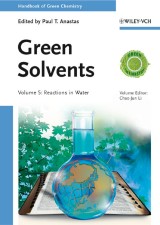Details

Green Solvents, Volume 5
Reactions in WaterHandbook of Green Chemistry 1. Aufl.
|
183,99 € |
|
| Verlag: | Wiley-VCH |
| Format: | |
| Veröffentl.: | 07.04.2014 |
| ISBN/EAN: | 9783527688562 |
| Sprache: | englisch |
| Anzahl Seiten: | 436 |
DRM-geschütztes eBook, Sie benötigen z.B. Adobe Digital Editions und eine Adobe ID zum Lesen.
Beschreibungen
The shift towards being as environmentally-friendly as possible has resulted in the need for this important volume on the topic of reactions in water. Edited by one of the leaders in the field, Professor C.-J. Li, this is an essential resource for anyone wishing to gain an understanding of the world of green chemistry, as well as for chemists, environmental agencies and chemical engineers.
THE PRINCIPLES OF AND REASONS FOR USING WATER AS A SOLVENT FOR GREEN CHEMISTRY<br> Introduction<br> Binding Two Species Together Driven by the Hydrophobic Effect in Water<br> Aromatic Chlorination<br> Acylation of Cyclodextrins by a Bound Ester<br> Mimics of Metalloenzymes Using the Hydrophobic Effect in Water<br> Mimics of the Enzyme Ribonuclease<br> Mimics of Enzymes that Use Pyridoxamine Phosphate and Pyridoxal Phosphate as Coenzymes<br> Artificial Enzymes Carrying Mimics of Thiamine Pyrophosphate<br> Enolizations and Aldol Condensations<br> Hydrophobic Acceleration of Diels-Alder Reactions<br> Selectivities in Water Induced by the Hydrophobic Effect -<br> Carbonyl Reductions<br> Selectivities in Water Induced by the Hydrophobic Effect -<br> Oxidations<br> Using Hydrophobic Effects in Water to Determine the Geometries of Transition States for Some Important Reactions<br> Conclusion<br> GREEN ACID CATALYSIS IN WATER<br> Introduction<br> Lewis Acids in Water<br> Chiral Lewis Acid-Catalyzed Asymmetric Reactions in Water<br> Bronsted Acid Catalysis in Pure Water<br> Conclusion and Perspective<br> GREEN BASES IN WATER<br> Introduction<br> Types of Bases and Their Use from a Green Point of View<br> Liquid-Liquid Processes<br> Solid-Liquid Processes<br> GREEN OXIDATION IN WATER<br> Introduction<br> Water-Soluble Ligands<br> Oxidations Catalyzed by Metalloporphyrins and Metallophthalocyanines<br> Epoxidation and Dihydroxylation of Olefins in Aqueous Media<br> Alcohol Oxidations in Aqueous Media<br> Aldehyde and Ketone Oxidations in Water<br> Sulfoxidations in Water<br> Conclusion<br> GREEN REDUCTION IN WATER<br> Introduction<br> Water-Soluble Ligands<br> Hydrogenation in Water<br> Transfer Hydrogenation in Water<br> Role of Water<br> Conclusion<br> COUPLING REACTIONS IN WATER<br> Introduction<br> Reaction of Carbonyl Compounds and Derivatives<br> Reaction of Alkenes and Alkynes<br> Reaction of Organic Halides and Derivatives<br> Conclusion<br> "ON WATER" FOR GREEN CHEMISTRY<br> Introduction<br> Pericyclic Reactions<br> Addition of Heteronucleophiles to Unsaturated Carbonyl Compounds<br> Enantioselective Direct Aldol Reactions<br> Coupling Reactions<br> Oxidation<br> Bromination Reactions<br> Miscellaneous Reactions<br> Theoretical Studies<br> Conclusion<br> PERICYCLIC REACTIONS IN WATER. TOWARD GREEN CHEMISTRY<br> Introduction<br> Pericyclic Reaction in Aqueous Media<br> Conclusion<br> NON-CONVENTIONAL ENERGY SOURCES FOR GREEN SYNTHESIS IN WATER (MICROWAVE, ULTRASOUND, AND PHOTO)<br> Introduction<br> MW-Assisted Organic Transformations in Aqueous Media<br> Sonochemical Organic Transformations in Aqueous Media<br> Photochemical Transformations in Aqueous Media<br> Conclusion<br> FUNCTIONALIZATION OF CARBOHYDRATES IN WATER<br> Introduction<br> C-C Bond Formation Reactions<br> C-N Bond Formation Reactions<br> Functionalization of Hydroxy Groups<br> Clyco-Organic Substrates and Reactions in Aqueous Sugar Solutions<br> Conclusion<br> WATER UNDER EXTREME CONDITIONS FOR GREEN CHEMISTRY<br> Introduction<br> Background<br> Recent Progress in HTW Synthesis<br> WATER AS A GREEN SOLVENT FOR PHARMACEUTICAL APPLICATIONS<br> Introduction -<br> Is Water a Green Solvent?<br> Water-Based Enzymatic Processes<br> Processes in Which the Product is Isolated by pH Adjustment to the Isoelectric Point<br> Carbon-Carbon Bond-Forming Cross-Coupling Reactions in Water<br> Pharmaceutical Processes Using Mixed Aqueous Solvents<br> Conclusion<br> WATER AS A GREEN SOLVENT FOR BULK CHEMICALS<br> Introduction<br> Hydroformylation -<br> An Overview<br> Water as Solvent for Hydroformylation<br> Water as Solvent in the Production of 2,7-Octadien-1-ol (Kurayray Process)<br> Conclusion<br> <br>
<b>Paul T. Anastas</b> joined Yale University as Professor and iserves as the Director of the Center for Green Chemistry and Green Engineering at Yale. From 2004-2006, Paul Anastas has been the Director of the Green Chemistry Institute in Washington, D.C. Until June of 2004 he served as Assistant Director for Environment at e White House Office of Science and Technology Policy where his responsibilities included a wide range of environmental science issues including furthering international public-private cooperation in areas of Science for Sustainability such as Green Chemistry. In 1991, he established the industry-government-university partnership Green Chemistry Program, which was expanded to include basic research, and the Presidential Green Chemistry Challenge Awards. He has published and edited several books in the field of Green Chemistry and developed the 12 principles of Green Chemistry.
<p>Green chemistry is a vitally important subject area in a world where being as green and environmentally sound as possible is no longer a luxury but a necessity. Its applications include the design of chemical products and processes that help to reduce or eliminate the use and generation of hazardous substances.</p> <p><i>The Handbook of Green Chemistry</i> comprises 12 volumes, split into subject-specific sets as follows:</p> <p>Set I: Green Catalysis<br /> Set II: Green Solvents<br /> <br /> • Volume 4: Supercritical Solvents<br /> • <b>Volume 5: Reactions in Water</b><br /> • Volume 6: Ionic Liquids</p> <p>Set III: Green Processes<br /> Set IV: Green Products</p> <p>Water, an extremely abundant resource, could be used in manufacturing as it is both a “green” solvent (if used properly) and an inexpensive one. One major asset in using water as a solvent is that the hydrophobic effects can lead to suspensions of normally insoluble compounds that facilitate remarkable new chemistry not otherwise achievable. A wide range of classical chemical reactions, normally associated with organic solvents, are discussed within this book.</p>


















